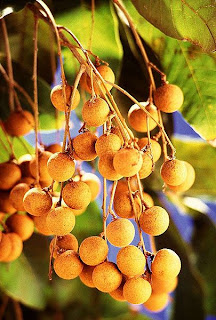
Dimocarpus longan, commonly known as the longan is a tropical tree that produces edible fruit. It is one of the better known tropical members of the soapberry family to which the lychee also belongs. It is native to the Indomalaya ecozone defined by South Asia and Southeast Asia.
The Dimocarpus longan tree can grow up to 6 to 7 meters in height, and the plant is very sensitive to frost. Longan trees require sandy soil and temperatures that do not typically go below 4.5 degrees Celsius (40.1 degrees Fahrenheit). Longans and lychees bear fruit at around the same time of the year.
The longan (龍眼lóng yǎn , lit. "dragon eye"), is so named because it resembles an eyeball when its fruit is shelled (the black seed shows through the translucent flesh like a pupil/iris). The seed is small, round and hard, and of an enamel-like, lacquered black. The fully ripened, freshly harvested shell is bark-like, thin, and firm, making the fruit easy to shell by squeezing the fruit out as if one is "cracking" a sunflower seed. When the shell has more moisture content and is more tender, the fruit becomes less convenient to shell. The tenderness of the shell varies due to either premature harvest,
variety, weather conditions, or transport/storage conditions.
The longan is listed as Near Threatened on the IUCN Red List.
A relative of the longan fruit is Lansium domesticum, better known as the langsat fruit, found in and around South East Asia.
The fruit is sweet, juicy and succulent in superior agricultural varieties and, apart from being eaten fresh, is also often used in East Asian soups, snacks, desserts, and sweet-and-sour foods, either fresh or dried, sometimes canned with syrup in supermarkets. The taste is different from lychees; while longan have a drier sweetness, lychees are often messily juicy with a more tropical, sour sweetness.
 The seed and the shell are not consumed.
The seed and the shell are not consumed.Dried longan, called guìyuán ( 桂圆 ) in Chinese, are often used in Chinese cuisine and Chinese sweet dessert soups. In Chinese food therapy and herbal medicine, it is believed to have an effect on relaxation. In contrast with the fresh fruit, which is juicy and white, the flesh of dried longans is dark brown to almost black. In Chinese medicine, the longan, much like the lychee, is thought to give internal "heat" ( 上火 ).
Potassium chlorate has been found to cause the longan tree to blossom. However, this causes stress on the tree if it is used excessively, and eventually kills it. (From Wikipedia)

Juice recommended
- Longan smoothie
- Longan juice boil
No comments:
Post a Comment